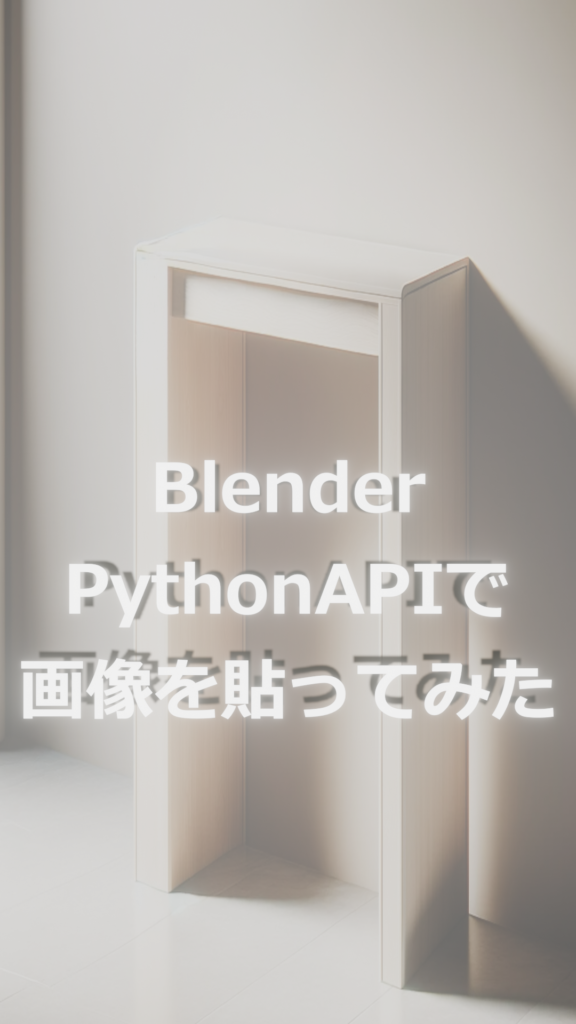はじめに
この記事では、Blender 4.0でPython APIを使用して平面のメッシュに画像を貼り付ける方法を説明します。このプロセスは、コマンドラインからBlenderを操作し、自動化タスクを実行する際に役立ちます。
こちらの記事もおすすめ
必要なツール
- Blender 4.0
- 基本的なPythonの知識
クリプトの準備
background_job_image.py
import bpy
import os
import sys
import argparse
import addon_utils
def set_object_scale(obj, scale_x, scale_y, scale_z):
obj.scale.x = scale_x
obj.scale.y = scale_y
obj.scale.z = scale_z
def set_object_location(obj, loc_x, loc_y, loc_z):
obj.location.x = loc_x
obj.location.y = loc_y
obj.location.z = loc_z
def create_text_object(text, font_path):
txt_data = bpy.data.curves.new(name="Text", type='FONT')
txt_data.body = text
txt_data.align_x = 'CENTER'
if os.path.exists(font_path):
txt_data.font = bpy.data.fonts.load(font_path)
else:
print(f"Font file not found: {font_path}")
return bpy.data.objects.new(name="TextObject", object_data=txt_data)
def setup_scene(scene, image_path, font_path, text):
scene.render.resolution_x = 1080
scene.render.resolution_y = 1920
scene.render.engine = 'BLENDER_EEVEE'
scene.eevee.use_bloom = True
text_obj = create_text_object(text, font_path)
scene.collection.objects.link(text_obj)
apply_emission_material_to_text(text_obj)
def configure_camera(scene):
cam_data = bpy.data.cameras.new("Camera")
cam_obj = bpy.data.objects.new("Camera", cam_data)
scene.collection.objects.link(cam_obj)
scene.camera = cam_obj
cam_obj.location = (0.0, 0.0, 14.0)
def configure_lighting(scene):
light_data = bpy.data.lights.new("Light", 'SUN')
light_obj = bpy.data.objects.new("Light", light_data)
scene.collection.objects.link(light_obj)
light_obj.location = (2.0, 2.0, 5.0)
light_obj.data.energy = 5.0
def create_emission_material():
mat = bpy.data.materials.new(name="EmissionMaterial")
mat.use_nodes = True
nodes = mat.node_tree.nodes
nodes.clear() # clear all the nodes
emission = nodes.new(type='ShaderNodeEmission')
emission.inputs[0].default_value = (1, 1, 1, 1) # white color
emission.inputs[1].default_value = 5.0 # strength
output = nodes.new(type='ShaderNodeOutputMaterial')
links = mat.node_tree.links
links.new(emission.outputs[0], output.inputs[0])
return mat
def apply_emission_material_to_text(text_obj):
emission_mat = create_emission_material()
text_obj.data.materials.append(emission_mat)
def save_and_render(scene, save_path, render_path):
if save_path:
bpy.ops.wm.save_as_mainfile(filepath=save_path)
if render_path:
scene.render.filepath = render_path
bpy.ops.render.render(write_still=True)
def enable_addon(addon_name):
loaded_default, loaded_state = addon_utils.check(addon_name)
if not loaded_state:
addon_utils.enable(addon_name, default_set=True)
print(f"Addon '{addon_name}' enabled.")
else:
print(f"Addon '{addon_name}' already enabled.")
def import_image_as_plane(image_path):
if os.path.exists(image_path):
bpy.ops.import_image.to_plane(files=[{"name": image_path}])
print(f"Image imported as plane: {image_path}")
else:
print(f"Image file not found: {image_path}")
def parse_arguments(argv):
parser = argparse.ArgumentParser()
parser.add_argument(
"-t", "--text", dest="text", type=str, default="Blender\nPythonAPIで\n画像を貼ってみた",
help="This text will be used to render an image",
)
parser.add_argument(
"-s", "--save", dest="save_path", metavar='FILE', default="/tmp/hello.blend",
help="Save the generated file to the specified path",
)
parser.add_argument(
"-r", "--render", dest="render_path", metavar='FILE', default="/tmp/hello4",
help="Render an image to the specified path",
)
parser.add_argument(
"-f", "--font", dest="font_path", type=str,
default="C:\\Windows\\Fonts\\meiryob.ttc", # Replace this with the correct path on your system
help="The path to the font file to use for rendering the text",
)
parser.add_argument(
"-b", "--background", dest="background_path", type=str,
default=r"D:\Prj\VideoPortraitMaker\image\background01.png", # Replace with the correct path to the background image
help="The path to the background image file to use",
)
# 引数をパース
args = parser.parse_args(argv)
return args
def setup_background(args):
enable_addon("io_import_images_as_planes")
import_image_as_plane(args.background_path)
obj = bpy.data.objects.get('background01')
set_object_scale(obj, 10.8, 21.6, 1)
set_object_location(obj, 0, 0, -1)
def main():
argv = sys.argv
# "--"の後の引数のみを取得
if "--" in argv:
argv = argv[argv.index("--") + 1:]
else:
argv = []
args = parse_arguments(argv)
if not args.text:
parser.print_help()
return
scene = bpy.context.scene
setup_scene(scene, args.background_path, args.font_path, args.text)
setup_background(args)
configure_camera(scene)
configure_lighting(scene)
save_and_render(scene, args.save_path, args.render_path)
if __name__ == "__main__":
main()
リポジトリ
参考サイト
